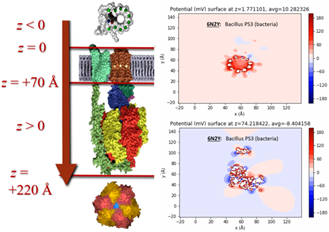Chérif F. Matta¹ ² ³
¹ Dép. de chimie, Université Laval, Québec, Québec, Canada G1V 0A6
² Dept. of Chemistry & Physics, Mount Saint Vincent University, Halifax, NS, Canada B3M 2J6
³ Dept. of Chemistry, Saint Mary's University, Halifax, NS, Canada B3H 3C3
Corresponding author: cherif.matta@msvu.ca
Abstract:
New biological functions of ATP synthase have recently been proposed. It is now thought that this enzyme interferes with the energetics of the reaction itself and not just with the potential energy barrier (which determines the rate) of the reaction. This unusual role is due to the enzyme's electrostatic potential. Crystallographic structures of ATP synthase for different species including human are used to compare their electrostatic potentials and electrostatic fields by solving the Poisson-Boltzmann equation in an environment simulating that of mitochondria.

The potential difference that a proton experiences solely due to the electrostatic potential of the enzyme itself is found to be within an order of magnitude of the chemosmotic potential difference. Meanwhile, ATP synthase is a sorting machine and, as such, operates as a (reverse) Maxwell’s demon and hence erasing information (producing disorder out of order) must be accompanied by a dissipation of entropy. It is therefore suggested that two new terms may need to be added to the textbook ΔG expression of chemosmotic theory which, with the added new terms, can now read:

The Fig. shows the electrostatic potential in two planes perpendicular to the long axis of the protein corresponding to the entry and exit points of the proton where the plane on entry (red) is clearly positive while the plane on exit is negative. Thus, ATP synthase, besides its putative role as a catalyst, modifies the ΔG of the proton translocation reaction from the intermembrane space to the mitochondrial matrix. It gives with one hand (through its electrostatic potential) what it takes with the other (as a Maxwell’s demon).
References:
- Vigneau, J.-N.; Fahimi, P., Ebert, M.; Cheng, Y.; Tannahill, C.; Muir, P.; Nguyen-Dang, T.-T.; Matta, C. F. ChemComm 58, 2650-2653 (2022).
- Fahimi, P.; Matta, C. F. Trends Chem. 4, 96-110 (2022).
- Matta, C. F., Massa, L. J. Phys. Chem. A 121, 9131-9135 (2017).
Recording:
Video is available only for registered users.